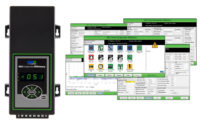
The
Aviva Stadium in Dublin, Ireland, seats 50,000.
Some 54 refrigerated cold rooms in Aviva Stadium support the onsite catering
services.
One of the largest refrigeration projects undertaken in recent years in the Irish capital, the installation required some 8 km of Ethernet cabling to connect up the cold rooms and associated refrigeration packs, condensing units, and controllers. The refrigeration system supports the stadium’s onsite catering facility, designed to meet surges in demand from the 50,000 capacity crowds on match days.
Martin Kerr of Montgomery Refrigeration, which carried out the installation, said, “It’s a large distributed system with great distances between the various elements, both horizontally and vertically through the seven tiers of the stadium.”
He added, “The RDM control ensures the entire system continues to operate at peak performance, reducing energy costs and pinpointing any potential issues before they become a problem.”
Among the 64 cold rooms, mainly used for cooling drinks, there are seven freezer rooms, all supported by six refrigeration compressor packs and seven condensing units located throughout the stadium.
IN CONTROL
Each cold room and freezer room is equipped with a Mercury control panel, while the packs and condensing units have Mercury plant controllers. The whole network is wired up to a state-of-the-art RDM Data Manager, which provides central monitoring, control, and alarm functions. The control system is equipped with an energy saving feature that caters for the particular sporadic nature of usage of the stadium’s facilities.Norman Johnson of RDM said, “The nature of variable usage patterns means that demand on the stadium’s catering facilities swings from practically zero between major events to full-throttle on big match days.

“We can program the system not to trigger alarms in the event of intentional system off, and save a great deal on energy costs in the process. It’s a great solution for hospitality facilities with big swings in demand for drinks.”
Sustainability and care for the environment are strong themes in the design of the stadium. For example, rainwater falling on the roof is harvested and channeled into a 320,000-liter capacity storage system.
It also employs a heat recovery system to harness waste energy from diesel generators to produce hot water for bathrooms, kitchens, and the under-pitch heating system.
Publication date: 08/02/2010





